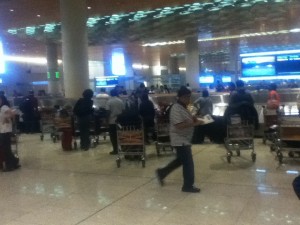By TIM ROSENKRANZ, 6/23/2014. A few days ago, I touched ground at Mumbai International Airport. Like most flights from the USA/Europe, I arrived in the night. The hours after midnight here are actually some of the most busy ones: Passengers hustle through security to catch their flights to Amsterdam or Singapore, while on the lower level streams of passengers rush through long hallways to immigration. It is my first time in the newly built international terminal. It is an impressive construction, which the state of Maharashtra underwent, to present a high-end welcome to thousands of tourists, overseas citizens and business travelers entering India’s financial capital daily by plane.
Airports in the global ethno- and econo-scapes are interfaces, where we encounter and interact with the place we try to enter, but also where the image of that place is formed. Mumbai’s airport presents itself as a mix of a luxury convention hotel, a contemporary art-gallery, and a stylized heritage museum. Luxurious dark, red carpets in long gangways contrast with bright halls for immigration and customs. Financed by public funds and under public supervision, the message produced here is clear: This is India, proud of its past, effective in its present and dynamic towards its future. A designed symphony of familiar tropes with an “Indian touch”, easing the transition for the global traveler.
The interface I encountered at Mumbai International Airport differs drastically from the first Indian interface, which I engaged with two weeks ago in New York, while trying to collect my sons visa and passport. Visa-offices are also interfaces and this one presented chaos and uncertainty. India processes most visas in the USA through a private subsidiary, in short: The government outsourced this part of its responsibility. I was unlucky to need a visa for my newborn son, while the Indian government was switching agencies from its former contractor BLS to “Cox and Kings.” I was not prepared for the hours, I would spend on the third floor of a rather shady office building in the Meatpacking district. Even though I received an e-mail that my son’s visa was ready to pick up, when I came to the building the document was nowhere to be found. Even worse, I was not the only one, nearly all of the ca. 60 people waiting in the half-finished service area had similar issues, some had been coming here now for days. The staff of domestic workers was rummaging through boxes and suitcases of processed and non-processed visas and passports dumped on them by the former contractor. I was lucky that they found my son’s documents after five hours.
I am bringing up these contrasting episodes with the two interfaces every tourist encounters before entering a country, because they show what is at stake. In a global tourist economy, tourists need to feel welcome. The destination therefore extends from the airport to the visa-office (or vice-versa). The images of the country (in my case India) produced here are vital, not only for the tourist experience, but for the very decisions tourists make. While I was waiting for my son’s visa in NYC, I observed three US-tourists, who stormed off with their unprocessed passports, swearing to “never-ever visit India.” These were people who already had decided to go to India, but were driven away.
Interestingly it was the private sector that failed. In a sphere of economic development that favors private enterprises over public control, this was an interesting start for my research in India.

